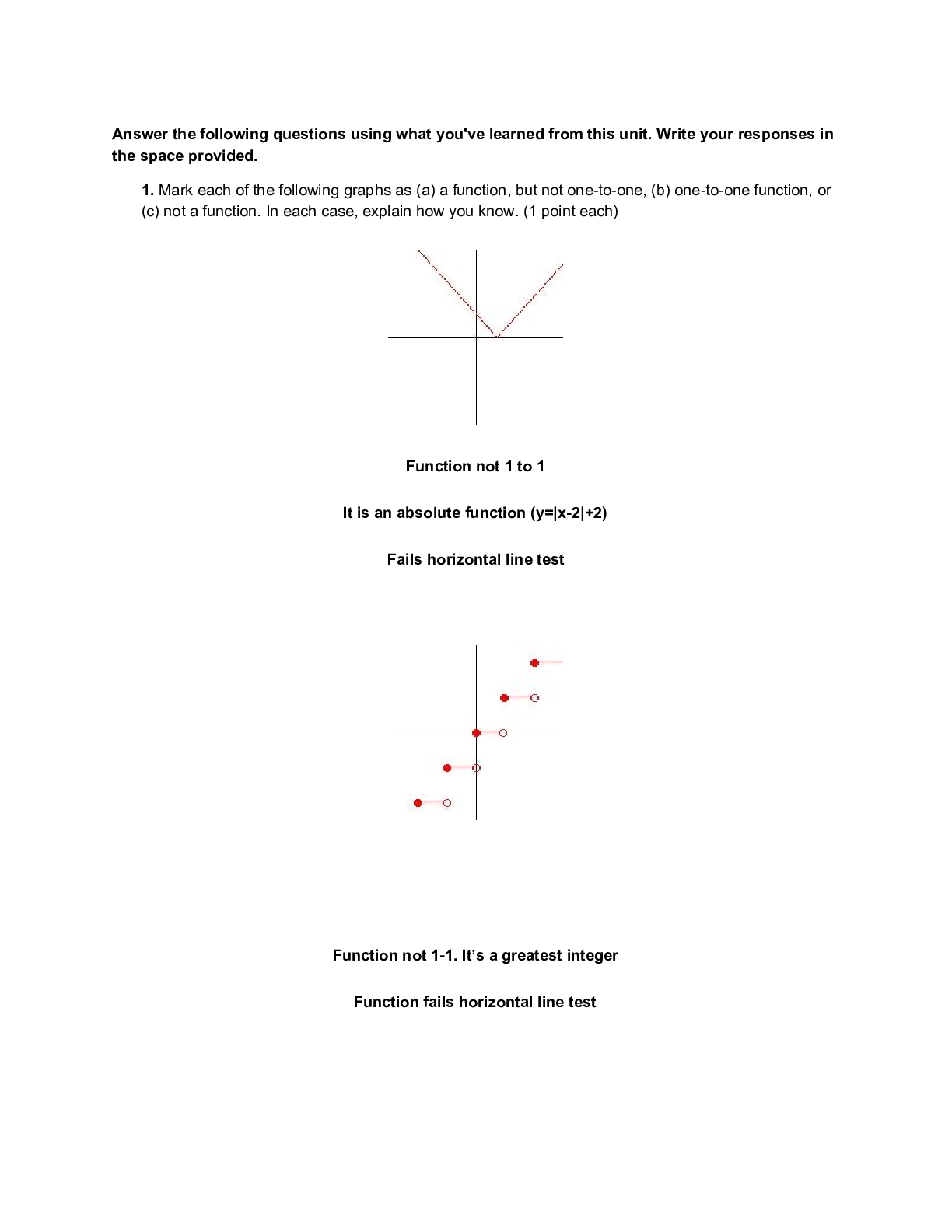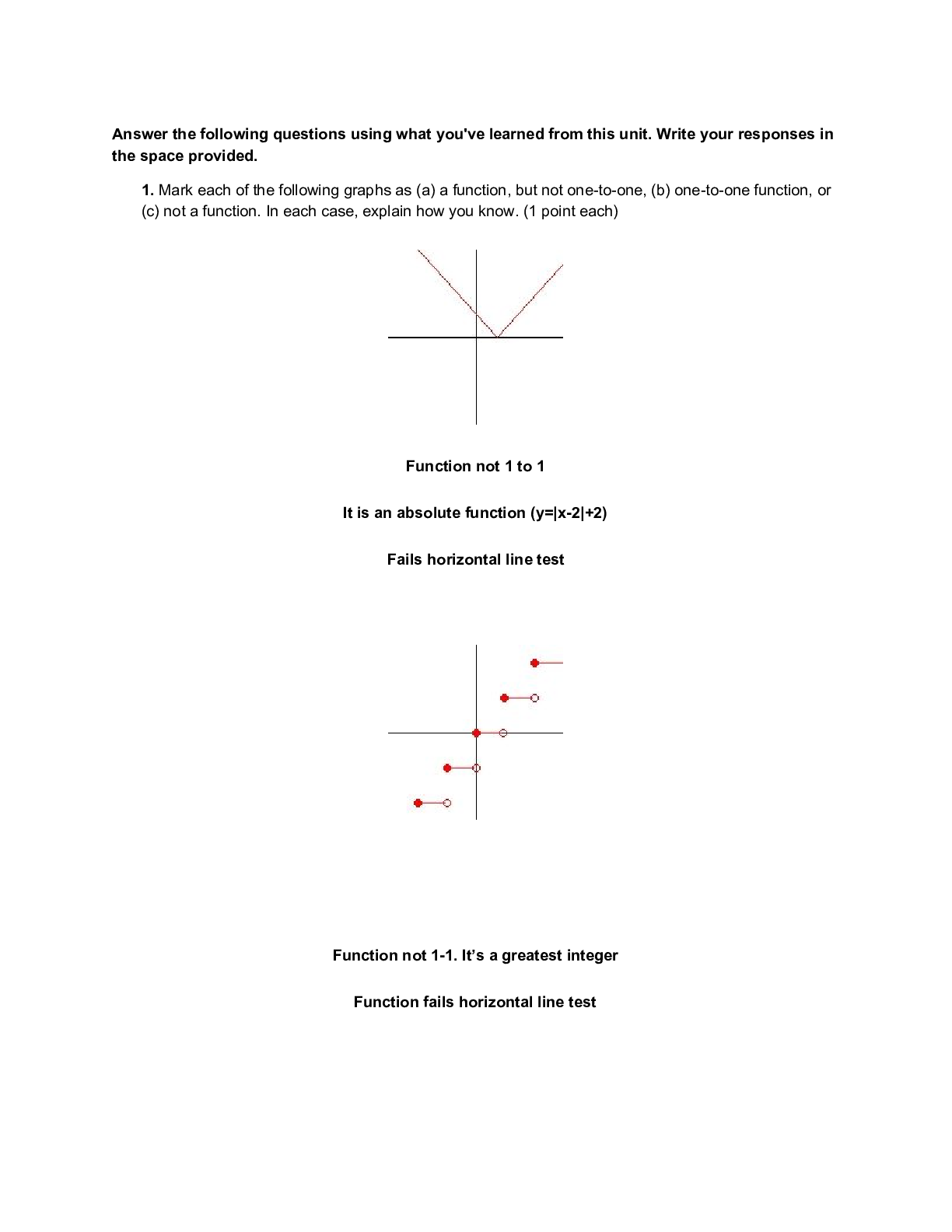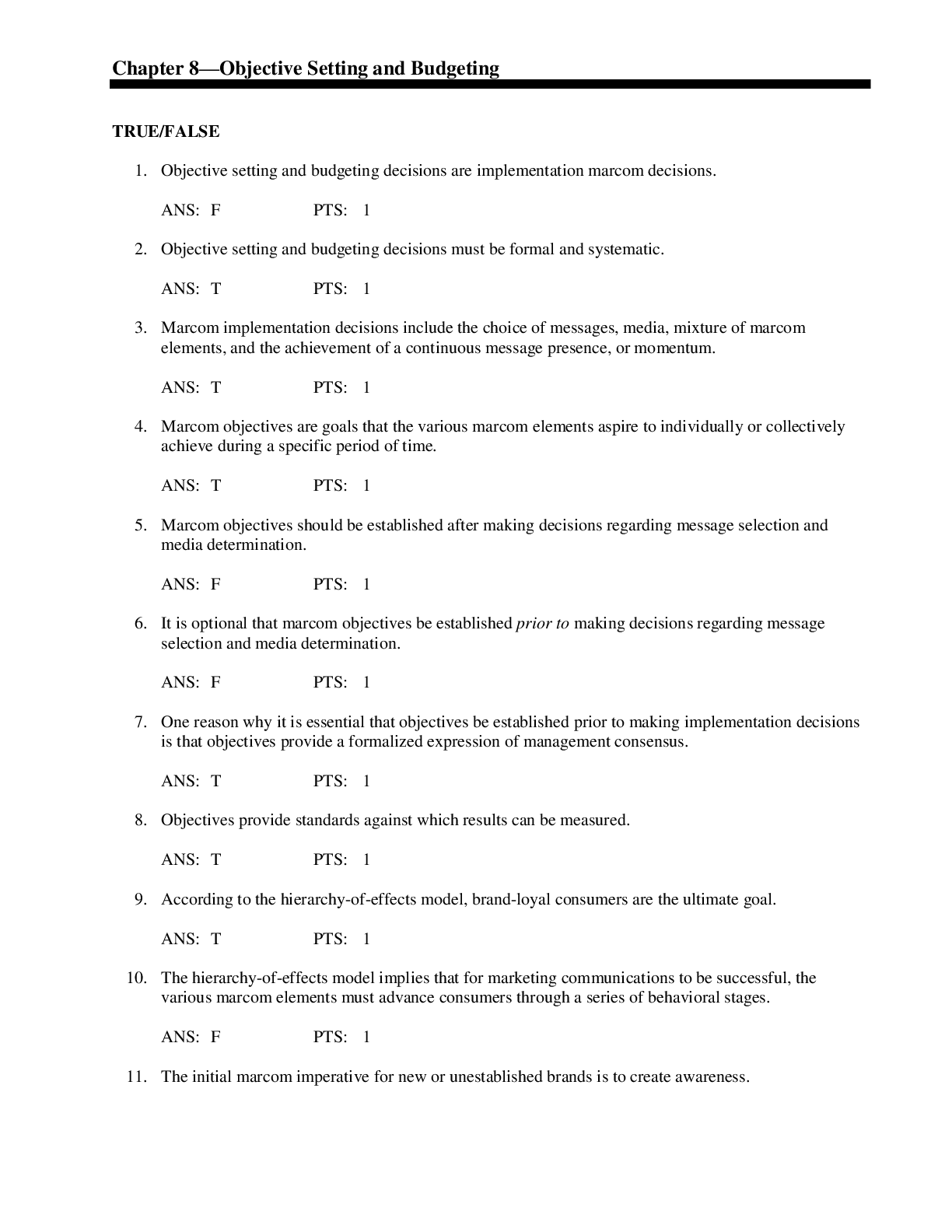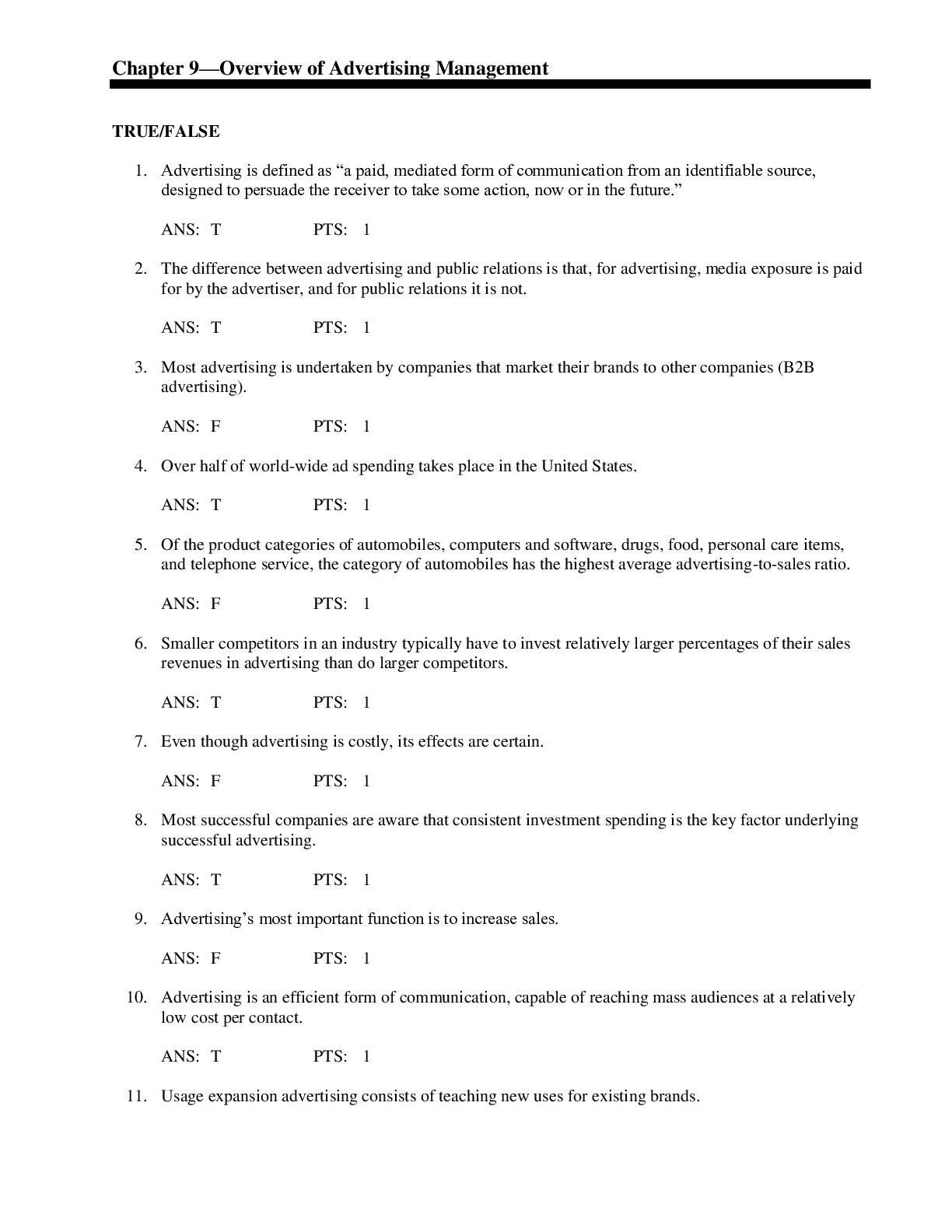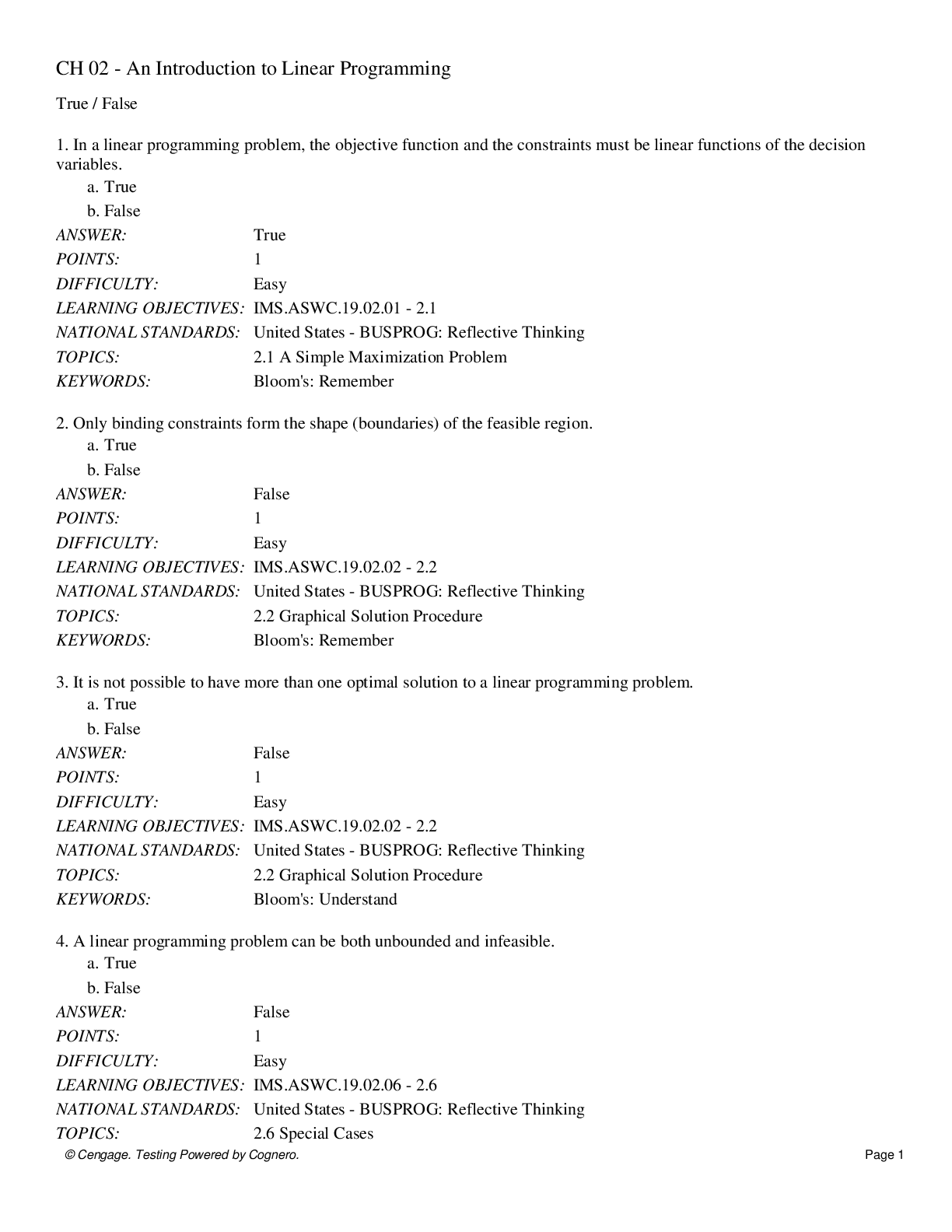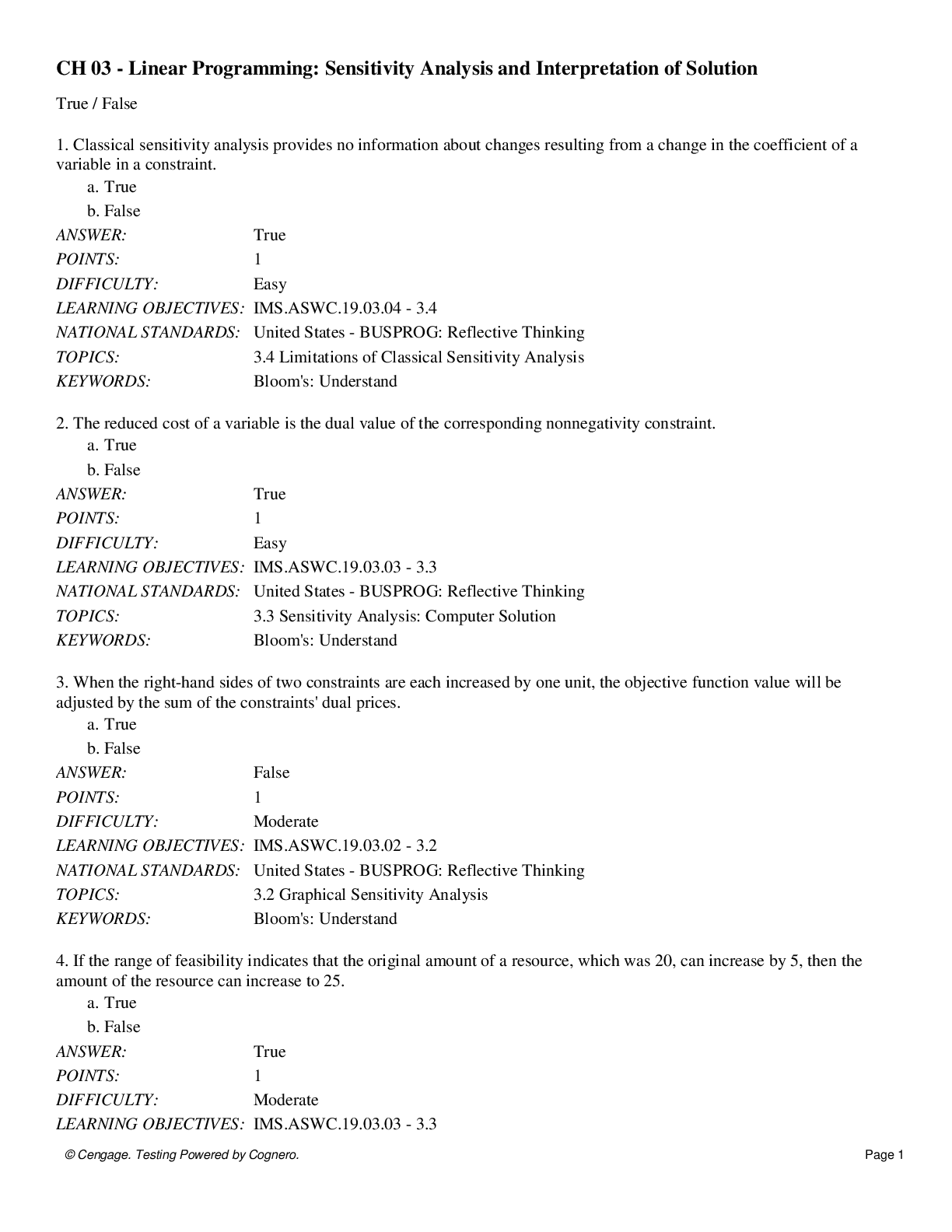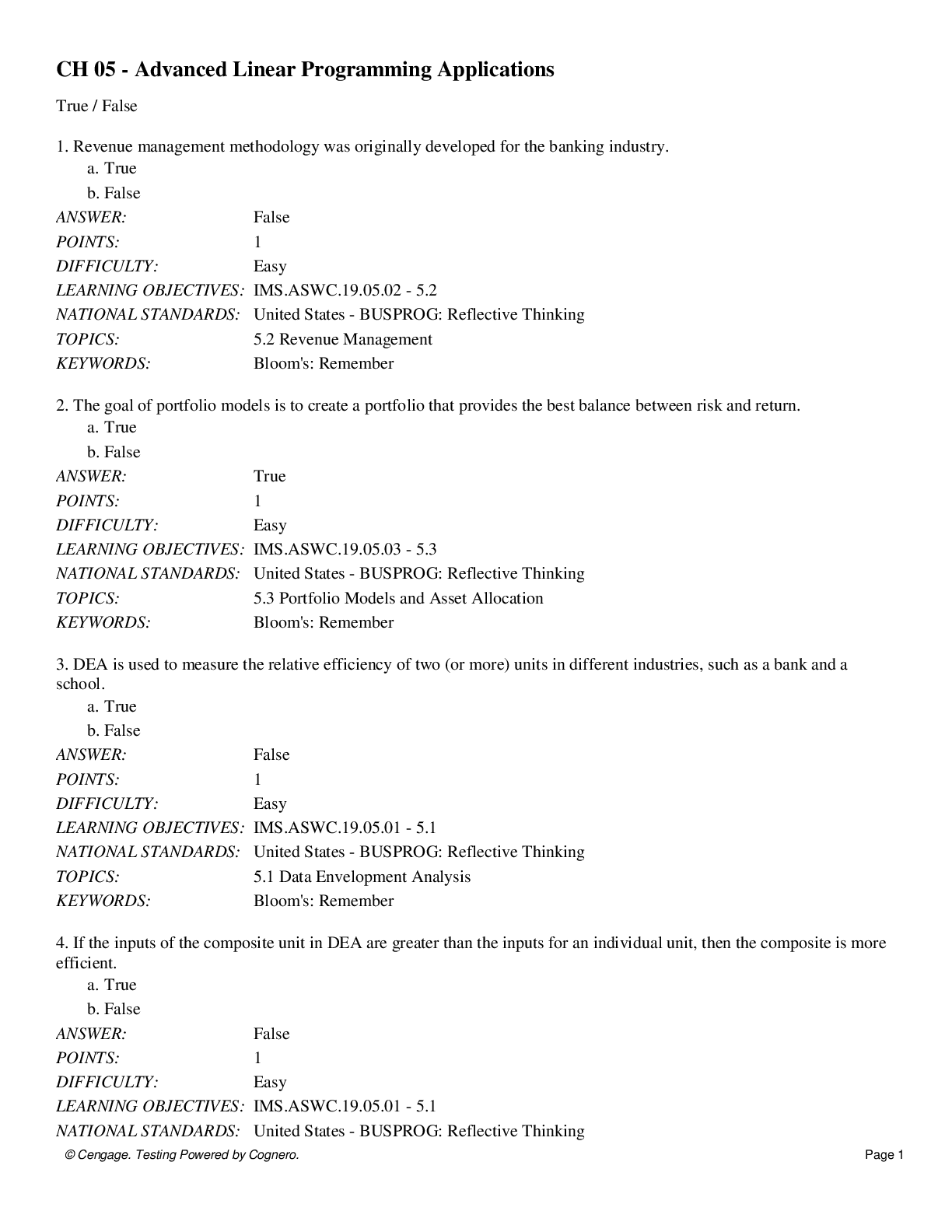*NURSING > QUESTIONS & ANSWERS > RN 231 Quiz 4_Cloned_Assessment 1. Detailed Answer Key With Rationale. 50 Most Occuring Questions a (All)
RN 231 Quiz 4_Cloned_Assessment 1. Detailed Answer Key With Rationale. 50 Most Occuring Questions and Answers
Document Content and Description Below
1. A nurse is caring for a client admitted to the emergency department with extensive partial and full-thickness burns of the head, neck, and chest. While planning the client's care, the nurse should ... be aware that initially the client is at greatest risk for A. airway obstruction. Rationale: Burns of the head, neck, and chest may involve damage to the pulmonary tree due to heat as well as smoke and soot inhalation. This can result in severe respiratory difficulty. Nursing measures to maintain a patent airway should take priority in this client's care. B. infection. Rationale: Although prevention of infection is an important aspect of burn care throughout hospitalization and treatment, there is a greater initial priority for this client. C. fluid imbalance. Rationale: Although adequate fluid replacement is an important aspect of burn care throughout the acute phase of burn treatment, there is a greater initial priority for this client. D. paralytic ileus. Rationale: Although paralytic ileus may occur during the acute phase aspect of burn care and may require nasogastric suctioning, there is a greater initial priority for this client. 2. A nurse in a burn treatment center is caring for a client who is admitted with severe burns to both lower extremities and is pending an escharotomy. The client's spouse asks the nurse what the procedure entails. Which of the following nursing statements is appropriate? A. "Large incisions will be made in the eschar to improve circulation." Rationale: An escharotomy is a surgical incision made to release pressure and improve circulation in a part of the body that has a deep burn and is experiencing excessive swelling. Burn injuries that encircle a body part, such as an arm or the chest, can cause swelling and tightness in the affected area, resulting in reduced circulation. Making surgical incisions into the burned tissue allows the skin to expand, reduces tightness and pressure, and improves circulation. B. "I can call the doctor back here if you want me to." Rationale: This is a nontherapeutic response that defers the client's concern and puts it on hold. C. "A piece of skin will be removed and grafted over the burned area." Rationale: A surgical procedure in which a piece of skin from one area of the client's body is transplanted to another area is called a skin graft. D. "Dead tissue will be surgically removed." Rationale: Debridement is the surgical removal of dead tissue. 3. A group of college students was attending a weekend football rally when one of the students stumbled and fell into the bonfire. Although several friends quickly intervened, the client sustained partial-thickness burns to both lower legs, chest, and both forearms. Which of the following is the priority nursing action when the client is brought into the emergency room? A. Cover the burned area with sterile gauze. Rationale: Infection is one of the leading causes of death with burn injuries. Because the integrity of the skin is breeched, it is vital to cover all burned areas with sterile gauze; however, this is not the priority concern at this time. B. Inspect mouth for signs of inhalation injuries. Rationale: Since the client sustained burns to the chest, there is a possibility that flames and smoke from the client's burning clothes could have caused an inhalation injury. The nurse should inspect the mouth and throat for soot and swelling. Using the airway, breathing, circulation (ABC) priority-setting framework, this is the priority concern at this time. C. Administer intravenous pain medication. Rationale: Because of the large percentage of burned area, this client will experience high levels of pain, since partial-thickness burns expose fragile nerve endings. Large doses of intravenous morphine or other narcotic analgesics will likely be needed for adequate pain control. Despite the fact that pain is an important issue, it is not the priority concern at this time. D. Draw blood for a complete blood cell (CBC) count. Rationale: Burn injuries, such as this one, that exceed 20% of body surface area are considered major burns, which affect the client’s metabolism, hemodynamic balance, and immune system. In the early stage of burns, increased capillary permeability allows sodium to enter cells while potassium leaks out, resulting in hyponatremia and hyperkalemia. An altered osmotic gradient and loss of intravascular fluid causes elevated hematocrit levels. Initial lab studies are important to create a baseline because of these systemic effects of burns. Those labs would include a CBC, electrolytes, BUN, creatinine, and blood glucose. While it is important to establish baseline data, it is not the priority concern at this time. 4. A nurse in an emergency department is caring for a client who has burns on the front and back of both his legs and arms. Using the rule of nines the nurse should document burns to which percentage of the client’s total body surface area (TBSA)? A. 9 percent Rationale: Each arm represents 9% of the client’s TBSA. B. 18 percent Rationale: Each leg represents 18% of the client’s TBSA. C. 36 percent Rationale: Both legs represent 36% of the client’s TBSA. D. 54 percent Rationale: Each arm represents 9% of the client’s TBSA and each leg represents 18% of the client’s TBSA totalling 54%. 5. A nurse is caring for a client who has full-thickness burns all over 75% of his body. Which of the following methods is appropriate to accurately monitor the cardiovascular system? A. Auscultate cuff blood pressure. Rationale: Clients who have a large percentage of burned body surface area often do not have an area for the nurse to safely apply the cuff. Additionally, cuff blood pressures are affected by peripheral vascular changes. B. Palpate pulse pressure. Rationale: Clients who have a large percentage of burned body surface area require critical care and accurate monitoring. Palpation of pulse pressure does not provide data to detect subtle changes in the cardiovascular system. C. Obtain a central venous pressure. Rationale: Clients who have a large percentage of burned body surface area require critical care and accurate monitoring. The central venous pressure provides important data but does not accurately detect changes in left heart pressure. D. Monitor the pulmonary artery pressure. Rationale: Clients who have a large percentage of burned body surface area require critical care and accurate monitoring. The pulmonary artery pressure provides an accurate assessment of the cardiovascular system by detecting changes in left heart pressure which can detect possible development of pulmonary edema. 6. A nurse is developing a plan of care for a client who is rehabilitating from major burns. Which of the following should the nurse include to provide emotional support? A. Assign assistive personnel to keep his room neat and clean. Rationale: This intervention is important for infection control but does not address the client’s need for emotional support. B. Rotate nursing staff so he can have varied interactions. Rationale: This intervention inhibits the development of a trusting, nurse-client relationship which is an important component of providing emotional support. C. Talk with him during wound care. Rationale: Talking with the client while providing care assists in the development of the nurse-client relationship and demonstrates caring. D. Keep family members aware of his condition. Rationale: This intervention does not address the client’s need for emotional support and may violate client confidentiality. 7. A nurse is assessing the depth and extent of a client who has severe burns to the face, neck, and upper extremities. Which of the following factors is the first priority when assessing the severity of the burn? A. Age of the client Rationale: The client’s age is important in the assessment of the client’s burns, but is not the priority. B. Associated medical history Rationale: The client’s associated medical history is important in the assessment of the client’s burns, but is not the priority. C. Location of the burn Rationale: When using the urgent vs. nonurgent approach to care, the nurse determines the priority is to assess the location of the burns that may lead to respiratory distress. D. Cause of the burn Rationale: The client’s cause of the burns is important in the assessment of the client’s burns, but is not the priority. 8. A nurse is monitoring the fluid replacement of a client who has sustained burns. Which of the following fluids is used in the first 24 hr following a burn injury? A. 5% dextrose in water Rationale: 5% dextrose in water is not the fluid used in the first 24 hr following a burn injury because a stress-induced pseudodiabetes often occurs after major burns and the administration of more dextrose would increase the possibility of hyperosmolar disease. B. 5% dextrose in normal saline Rationale: 5% dextrose in normal saline is not the fluid used in the first 24 hr following a burn injury because a stress-induced pseudodiabetes often occurs after major burns and the administration of more dextrose would increase the possibility of hyperosmolar disease. C. Normal saline Rationale: Normal saline is not the fluid used in the first 24 hr following a burn injury because the burn causes generalized increased capillary permeability and crystalloids leak out of the burn area into areas such as the pulmonary interstitial spaces and may cause pulmonary edema. D. Lactated Ringer’s Rationale: Lactated Ringer’s is a fluid used in the first 24 hr following a burn injury. 9. A nurse is caring for a client with burns to face, ears, and eyelids. Which of the following is the priority finding to report to the provider? A. Urinary output 25 mL/hr Rationale: While a urinary output of 25 mL/hr is below the expected output of 30 – 50 mL/hr and should be reported to the provider, this is not the priority finding to report. B. Difficulty swallowing Rationale: Difficulty swallowing is an indication that the client’s airway is becoming obstructed, and is the priority to report to the provider. C. Heart rate 122 beats/min Rationale: While a heart rate of 122 beats/min is above the expected reference range and should be reported to the provider, this is not the priority finding to report. D. Lip edema Rationale: While lip edema is not an expected finding and should be reported to the provider, this is not the priority finding to report. 10. A client arrives at the emergency department following an explosion at a chemical plant. He has deep partial- and full-thickness chemical burns over more than 25% of his body surface area. What is the nurse’s priority intervention for this client? A. Initiate fluid resuscitation. Rationale: The client will require fluid resuscitation, but this is not the highest priority at this time. B. Medicate for pain. Rationale: The client will require pain medication, but this is not the highest priority at this time. C. Administer antibiotics. Rationale: The client will require antibiotics, but this is not the highest priority at this time. D. Maintain a patent airway. Rationale: The priority action the nurse should take when using the airway, breathing, and circulation (ABC) approach to client care is to keep the client’s airway patent, as the smoke and other irritants from the workplace explosion can cause swelling that can obstruct the trachea. 11. A nurse is planning care for a client who has a GI bleed. Which of the following actions should the nurse take first? A. Assess orthostatic blood pressure. Rationale: The first action the nurse should take using the nursing process is to assess the client; therefore, assessing the orthostatic blood pressure is the first priority to determine if the client is hypovolemic. B. Explain the procedure for an upper GI series. Rationale: The nurse should explain the procedure for an upper GI series, but this is not the priority. C. Administer pain medication. Rationale: The nurse should administer pain medication as needed, but this is not the priority. D. Test the emesis for blood. Rationale: The nurse should test the emesis for blood if the client vomits, but this is not the priority. 12. A nurse is caring for a client who has peptic ulcer disease. The nurse knows to monitor the client for which of the following findings as an indication of the complication of gastrointestinal perforation? A. Hyperactive bowel sounds Rationale: With gastrointestinal perforation, bowel sounds decrease and paralytic ileus results. B. Sudden abdominal pain Rationale: Classic indications of gastrointestinal perforation include sudden sharp abdominal pain, with a rigid abdomen, declining peristalsis, and progression to septicemia and hypovolemic shock. C. Increased blood pressure Rationale: Blood pressure generally decreases with gastrointestinal perforation due to hemorrhage and the progression to hypovolemic shock. D. Bradycardia Rationale: Tachycardia is more likely with gastrointestinal perforation due to the progression to hypovolemic shock. 13. A nurse is caring for a client who just had an upper gastrointestinal endoscopic procedure. Which of the following is the assessment priority for this client? A. Pain Rationale: Following endoscopy, the nurse should monitor the client for pain and intervene accordingly, but there is a higher priority in monitoring this client. B. Nausea Rationale: Following endoscopy, the nurse should monitor the client for nausea and intervene accordingly, but there is a higher priority in monitoring this client. C. Gag reflex Rationale: The greatest risk to the client’s safety following endoscopy is aspiration. Until the client’s gag reflex returns, the nurse must keep to client NPO and prepare to intervene to keep the airway open and unobstructed. D. Level of consciousness Rationale: Following endoscopy, the nurse should monitor the client’s level of consciousness, but there is a higher priority in monitoring this client. 14. A client is admitted with an active upper gastrointestinal (GI) bleed. After inserting a NG tube into the client, which of the following findings should the nurse anticipate? A. Bright red drainage Rationale: Red drainage indicates an active upper GI bleed. B. Dark amber drainage Rationale: Dark amber is generally the color used to describe the urine output of clients who are dehydrated. C. "Coffee-ground" drainage Rationale: "Coffee-ground" drainage or emesis indicates an old gastrointestinal bleed, or one that has been resolved. D. Greenish yellow drainage Rationale: Greenish yellow drainage is normal NG drainage representative of bile. 15. A client is receiving pancreatic enzymes as a digestive aid. The nurse should tell the client expect which of the following gastrointestinal changes? A. Increased mucus in stools Rationale: Clients do not take pancreatic enzymes to treat inflammatory bowel disease. B. Decreased black tarry stools Rationale: Clients do not take pancreatic enzymes to treat gastrointestinal bleeding. C. Increased watery stools Rationale: Although large doses of pancreatic enzymes can cause diarrhea, the usual dosing protocols should not cause this effect. D. Decreased fat in stools Rationale: Clients who have cystic fibrosis or pancreatitis, for example, need to supplement meals with oral pancreatic enzymes to reduce the fat content in their stools. Clients receiving pancreatic enzymes as a digestive aid should expect to have a reduction of fat in their stools. 16. A triage nurse in an emergency department is caring for a client who has a gunshot wound to the right side of her chest. The nurse notes a thick dressing on the chest and a sucking noise coming from the wound. The client has a blood pressure of 100/60 mm Hg, a weak pulse rate of 118/min, and a respiratory rate of 40/min. Which of the following actions should the nurse take initially? A. Raise the foot of the bed to a 90° angle. Rationale: Trendelenburg position increases pressure on the heart and lungs and is contraindicated for a client who has an open chest wound. B. Remove the dressing to inspect the wound. Rationale: A dressing should not be removed from a sucking chest wound until immediately prior to chest tube insertion. Removal of the dressing will cause an increase in size of the pneumothorax and increased respiratory difficulty. C. Prepare to insert a central line. Rationale: Although the client may need IV access, a central line is not usually needed in this situation. D. Administer oxygen via nasal cannula. Rationale: The client has an increased respiratory rate and heart rate, indicating that she is having respiratory difficulty. Administering oxygen will increase the oxygen exchange in the lungs and the oxygen available to the tissues. 17. A nurse in an emergency department is caring for a client who was bitten on the left leg by a poisonous snake. The client has placed elastic bandages snuggly above and below the bite marks and is in no apparent distress. The nurse should A. discharge the client. Rationale: Discharging the client is not indicated. The client needs to be treated and assessed by the nurse. B. obtain a prescription for the appropriate anti-venom. Rationale: Anti-venom is used to treat the bites of certain poisonous snakes. The appropriate anti-venom must be administered for the specific species of snake. C. remove both of the elastic bandages from the leg. Rationale: Releasing the bandages prior to administering the appropriate anti-venom may allow the spread of the venom, resulting in serious systemic consequences. D. obtain an order for pain medication. Rationale: Obtaining an order for pain medication is not indicated and may mask other symptoms the client may be experiencing. 18. Following a suicide bombing at a shopping mall, an unidentified, unconscious client is admitted to the emergency department with an acute intra-abdominal hemorrhage. The nurse should recognize that consent for the surgery A. should be obtained from an officer of the court. Rationale: Awaiting legal intervention could mean an inordinate delay until surgery is performed. B. must be obtained from a relative of the client. Rationale: In urgent situations, it is preferable for consent to be obtained from a relative or health care proxy (HCP). However, in this situation, the next of kin cannot be readily identified. C. can be inferred since the client is in critical condition. Rationale: The client is unconscious and in critical condition, and consequently, is incapable of providing consent. Preferably, consent should be obtained from a relative or health care proxy (HCP). However, the client is also unidentified, meaning the client could die while awaiting identification and next of kin. Therefore, consent should be implied and the surgery will be performed as an emergency life-saving procedure. D. will be delayed until the client is identified. Rationale: This is not an appropriate action. The client could die awaiting identification and next of kin. 19. A client is admitted to the emergency room with a respiratory rate of seven per min. Arterial blood gases (ABG) reveal the following values. Which of the following is an appropriate analysis of the ABGs? pH 7.22 PaCO2 68 mm Hg Base excess -2 PaO2 78 mm HG Saturation 80% Bicarbonate 28 mEq/L A. Respiratory acidosis Rationale: The normal pH is 7.35 to 7.45. The pH of 7.22 indicates that this client is acidotic. In this example, the pH is decreased while the PCO2 is elevated. Therefore, the correct interpretation of the results is that the client is in respiratory acidosis. B. Metabolic acidosis Rationale: This is not the correct analysis of the ABGs. C. Metabolic alkalosis Rationale: This is not the correct analysis of the ABGs. D. Respiratory alkalosis Rationale: This is not the correct analysis of the ABGs. 20. A nurse is triaging clients in the emergency department. Which of the following clients should the nurse request the provider should see first? A. A toddler who has asthma and has a pulse oximetry reading of 95% while receiving oxygen at 2 L/min. Rationale: A pulse oximetry reading of 95% while receiving oxygen at 2 L/min is an expected finding for a toddler who has asthma. This client is not the priority. B. A toddler who has otitis media, a temperature of 39.2 ° C (102.6° F) and purulent ear discharge. Rationale: An elevated temperature and purulent ear drainage are expected findings for a toddler who has otitis media. This client is not the priority. C. A school-age child who has acute epiglottitis, is drooling, and has an absence of spontaneous cough. Rationale: A school-age child who has acute epiglottitis, is drooling, and has an absence of spontaneous cough is unstable and requires immediate medical attention; therefore, this client is the highest priority and the nurse should attend to this client first. D. An adolescent who has sickle cell disease, reports pain level of 7 on a scale of 0 to 10, and requests pain medication. Rationale: Report of pain level of 7 on a scale of 0 to 10, and request for pain medication are expected findings for an adolescent who has sickle cell disease. This client is not the priority. 21. A nurse is caring for a client who enters the emergency department of severe chest pain. Which of the following interventions should the nurse implement to determine if the client is experiencing a myocardial infarction? A. Check the client's blood pressure. Rationale: The nurse should check the client’s vital signs when chest pain is present; however, these findings will not determine if the client is experiencing a myocardial infarction. B. Auscultate heart tones. Rationale: The nurse should auscultate heart tones as part of a complete assessment when a client complains of chest pain; however, these findings will not determine if the client is experiencing a myocardial infarction. C. Perform a 12-lead ECG Rationale: The nurse should perform a 12-lead ECG when a client complains of chest pain to determine if the client is experiencing a myocardial infarction. D. Determine if pain radiates to the left arm. Rationale: The nurse should identify the location of pain as part of a complete assessment however radiation to the left arm can be present in other conditions and therefore does not indicate that the client is experiencing a myocardial infarction. 22. A nurse in the emergency department is caring for a client who has anaphylaxis following a bee sting. Which of the following is the priority intervention? A. Observe for periorbital edema. Rationale: The nurse should observe for periorbital edema; however, this is not the priority intervention when taking the airway, breathing, circulation (ABC) approach to client care. B. Evaluate for local edema. Rationale: The nurse should evaluate for local edema; however, this is not the priority intervention when taking the airway, breathing, circulation (ABC) approach to client care. C. Auscultate for wheezing. Rationale: The nurse should first auscultate for wheezing when taking the airway, breathing, circulation (ABC) approach to client care. D. Monitor for hypotension. Rationale: The nurse should monitor for hypotension; however, this is not the priority intervention when taking the airway, breathing, circulation (ABC) approach to client care. 23. A nurse is caring for a client who is brought into the emergency department immediately following a snake bite to his forearm. The client suspects the snake to be venomous. Which of the following nursing interventions is appropriate? A. Apply an ice pack to the site of the bite. Rationale: The client should be kept warm following a snake bite and ice should not be applied to the site. B. Apply a tourniquet just above the elbow. Rationale: The application of a tourniquet is generally avoided following a snake bite due to the risk of nerve and tissue damage. C. Administer a corticosteroid. Rationale: Corticosteroids are not administered immediately following a snake bite due to the risk of decreasing the effects of antivenin. D. Place the extremity in a dependent position. Rationale: The affected area should be placed in a dependent position to decrease the circulation of venom. 24. A nurse in an emergency department is caring for a client who has a deep laceration on her left lower forearm and is bleeding heavily from the wound. Which of the following interventions should the nurse perform first? A. Apply a tourniquet just above the wound. Rationale: The application of a tourniquet is appropriate only after other methods fail to control the bleeding. B. Apply pressure directly to the wound. Rationale: The initial action to control bleeding is to apply pressure directly to the area or to the artery proximal to the wound. C. Elevate the extremity. Rationale: Elevating the extremity is an appropriate intervention but it is not the priority action. D. Place the client in a modified Trendelenburg position. Rationale: Placing the client in a modified Trendelenburg position is an appropriate intervention but it is not the priority action. 25. A nurse in the emergency department is caring for a client who is comatose. The provider suspects ketoacidosis. Which of the following is an expected finding? A. Malignant hypertension Rationale: Hypotension is an expected finding for ketoacidosis. B. Acetone odor to breath Rationale: Acetone odor to breath is an expected finding for ketoacidosis. C. Cheyne-Stokes breathing Rationale: Kussmaul respirations are an expected finding for ketoacidosis. D. Blood glucose level below 40 mg/dL Rationale: A blood glucose level between 300 and 800 mg/dL is an expected finding for ketoacidosis. 26. A nurse in an emergency department is preparing to care for a client who is being brought in with multiple system trauma following a motor vehicle crash. Which of the following is the priority focus of care? A. Airway protection Rationale: Airway protection is the priority focus when using the airway, breathing, circulation approach to client care. B. Decreasing intracranial pressure Rationale: Decreasing intracranial pressure is not the priority when using the airway, breathing, circulation approach to client care. C. Stabilizing cardiac arrhythmias Rationale: Stabilizing cardiac arrhythmias is not the priority when using the airway, breathing, circulation approach to client care. D. Preventing musculoskeletal disability Rationale: Preventing musculoskeletal disability is not the priority when using the airway, breathing, circulation approach to client care. 27. A nurse is caring for a client who is brought to the emergency room and has burn injuries. Which of the following findings indicates a deep partial-thickness burn? A. Burned area is black in color and pain is absent. Rationale: This finding indicates a deep full-thickness burn. B. Burned area is pink in color with blisters present. Rationale: This finding indicates a superficial partial-thickness burn. C. Burned area is red in color with eschar present. Rationale: This finding indicates a deep partial-thickness burn. Additional findings may include moderate edema and reports of pain. D. Burned area is yellow in color with severe edema. Rationale: This finding indicates a full-thickness burn. 28. An emergency room nurse is caring for a client following an automobile crash. Upon assessment the nurse observes bleeding from the client’s nose. Which of the following interventions is appropriate? A. Obtain a culture of the specimen using sterile swabs. Rationale: The collection of a culture specimen using any type of swab suction is contraindicated because brain tissue may be inadvertently removed at the same time or other tissue damage may result. B. Allow the drainage to drip onto a sterile gauze pad. Rationale: The nurse should allow the drainage to drip onto a sterile gauze pad assess for the presence of cerebrospinal fluid. This intervention allows for the collection of data without increasing the risk for further injury. C. Suction the nose gently with a bulb syringe. Rationale: Suctioning the nose is contraindicated because brain tissue may be inadvertently removed at the same time or other tissue damage may result. D. Insert sterile packing into the nares. Rationale: The nurse should avoid placing anything into the nares due to the risk of causing further injury. 29. A nurse is caring for a client who came to the emergency department reporting chest pain. The provider suspects a myocardial infarction. While waiting for the laboratory to report the client’s troponin levels, the client asks what this blood test will show. The nurse should explain that troponin is A. an enzyme that indicates damage to brain, heart, and skeletal muscle tissues. Rationale: Creatine kinase is an enzyme that indicates damage to brain, heart, and skeletal muscle tissue. B. a protein whose levels reflect the risk for coronary artery disease. Rationale: Cholesterol is a protein whose levels reflect the risk for coronary artery disease. C. a heart muscle protein that appears in the bloodstream when there is damage to the heart. Rationale: Troponin is a myocardial muscle protein that releases into the bloodstream when there is injury to the myocardial muscle. Troponin levels are point-of-care testing for clients who are having or are at risk for having a myocardial infarction. D. a protein that helps transport oxygen throughout the body. Rationale: Myoglobin is a heme protein whose function is to distribute oxygen throughout the body. 30. A nurse is working with an emergency response team in caring for a group of people who were creditably exposed to anthrax. Which of the following is the appropriate action for the nurse to take? A. Place clients in isolation. Rationale: Clients exposed to anthrax are not contagious; therefore, the nurse is not required to place them in isolation. B. Initiate client decontamination. Rationale: Clients exposed to anthrax do not require decontamination C. Administer to clients an antibiotics. Rationale: The nurse should administer an antibiotic as prophylaxis to all clients newly exposed to anthrax. D. Treat clients with antitoxin. Rationale: The nurse will not administer antitoxin to clients exposed anthrax, but will to those clients exposed to botulism. 31. A nurse in the emergency department is caring for a client who is bleeding profusely from a deep laceration on his left lower forearm. After observing standard precautions, which of the following should the nurse plan to do first? A. Apply a tourniquet just below the elbow. Rationale: The nurse should apply a tourniquet only as a last resort to stop external extremity bleeding. B. Apply pressure directly over the wound. Rationale: The greatest risk to the client is injury from hemorrhage; therefore, the priority action is to apply pressure directly over the wound to stop external extremity bleeding. C. Cleanse the wound. Rationale: The nurse should cleanse the wound after the external extremity bleeding is controlled. D. Elevate the limb and apply ice. Rationale: The nurse should elevate the limb after pressure is applied directly over the area of the bleed. 32. A nurse is working with an interdisciplinary committee in the development of a community-wide emergency response plan in the event of a disaster. The nurse should assure that the community’s emergency communication plan for a non-biological or chemical incident includes which of the following agencies to be notified immediately following the call to 911? A. Office of Emergency Management Rationale: The nurse would include the Office of Emergency Management in the community communication plan to be contacted following the call to the emergency communication center (911). This agency is responsible for determining if additional resources to the initial first responders are needed. B. The Federal Emergency Management Agency Rationale: The nurse would not include the Federal Emergency Management Agency to be immediately notified following a 911 call in the community communication plan. This agency is notified when determined by a community that local abilities are unable to properly respond to the incident. C. American Red Cross Rationale: The nurse would not include the American Red Cross as the next agency to be notified following a 911 call during a community wide disaster. This agency provides response efforts that support emergency rescue and recovery services and is contacted when additional resources are deemed needed by the local community. D. U.S. Department of Homeland Security Rationale: The nurse would not include this agency in the communication plan for non-terrorism incidents. The U.S. Department of Homeland Security should be notified in response to threats and hazards by acts of terrorism. 33. A nurse is preparing medication for a client. The nurse is called away for an emergency with another client, which of the following should the nurse do? A. Have another nurse guard the medication preparations until the nurse returns. Rationale: A nurse should always administer medication he/she has prepared for their client. This is part of the 6 Rights of Medication. B. Have another nurse finish preparing the medications. Rationale: A nurse should always prepare the medication as well as administer for their client. This is part of the 6 Rights of Medication. C. Lock the medicines in a room and finish when the nurse returns from the emergency situation. Rationale: Locking the medication in a secured area until the nurse returns to finish the preparation is the proper action for the nurse to take. This allows the nurse to continue where she left off in the steps of the 6 Rights of Medication and decreases the probability for error. D. Discard the prepared medications and begin again upon return. Rationale: A nurse should not discard medication unless she has drawn the incorrect amount of medication or is wasting a medication. 34. An occupational health nurse is instructing workers at an industrial facility in emergency procedures in the event of a traumatic amputation. Which of the following guidelines should the nurse included for preserving the amputated part for possible surgical reattachment? (Select all that apply.) A. Wrap the part in dry sterile gauze. B. Place the severed end of the part into crushed ice. C. Put the severed part in a dry, waterproof plastic bag. D. Wrap the covered part in an elastic bandage. E. Prevent contact of the severed part with water. 35. A nurse in the emergency department is caring for a client who was injured in a motor-vehicle crash. The client reports dyspnea and severe pain. The nurse notes that his chest moves inward during inspiration and bulges out during expiration. The nurse should suspect which of the following? A. Atelectasis Rationale: Atelectasis involves collapsed, airless alveoli. B. Flail chest Rationale: Flail chest results from multiple rib fractures that cause instability. During inspiration, the thorax moves inward, and during expiration it bulges out. This paradoxic chest movement prevents adequate ventilation of the injured lung. C. Hemothorax Rationale: Hemothorax is blood in the pleural space and involves decreased movement of the involved chest wall. D. Pneumothorax Rationale: Pneumothorax is air in the pleural space and involves decreased movement of the involved chest wall. 36. A nurse is in servicing a group of clients at the community center on the early detection for colorectal cancer. The nurse knows that the American Cancer Society recommends that persons who are asymptomatic, have no risk factors, and are age 50 or older should have a rectal examine with fecal occult blood testing every A. five years. Rationale: Five years is too long for the client to have this testing completed. B. six months. Rationale: Six months is too soon for the client to have this testing completed. C. one year. Rationale: One year is too soon for the client to have this testing completed. D. two years. Rationale: Two years is the correct time for client to have this testing competed. 37. A nurse is in-servicing a group of clients in the community on early detection for colorectal cancer. The nurse knows that the American Cancer Society recommends that men and women beginning at age 50 are at average risk and should have flexible sigmoidoscopy every A. five years. Rationale: Five years is the correct time frame for a client to have this testing completed. B. six months. Rationale: Six months is too soon for a client to have this testing completed. C. one year. Rationale: One year is too soon for a client to have this testing completed. D. two years. Rationale: Two years is too soon for a client to have this testing competed. 38. A nurse is educating a client who is being treated for metastatic colorectal cancer with bevacizumab (Avastin). Which of the following information should the nurse include? A. May expect to have weight gain. Rationale: A nurse should not include in the information that the client may expect to have weight gain, because weight loss is an adverse effect of Avastin. B. May expect to have mild hearing loss. Rationale: A nurse should not include in the information that the client may expect to have mild hearing loss, because it is not an adverse effect of Avastin. C. May expect temporary loss of smell. Rationale: A nurse should not include in the information that the client may expect temporary loss of smell because sensory loss of taste is an adverse effect of Avastin. D. May expect to have swelling of the legs. Rationale: A nurse should include in the information that the client may have swelling of the legs and should report the finding to the provider, because Avastin can cause heart failure. 39. A nurse is conducting a primary survey of a client who has sustained life-threatening injuries due to a motor-vehicle crash. Identify the sequence of actions the nurse should take. (Move the actions into the box on the right, placing them in the selected order of performance. Use all the steps.) C. Open the airway using a jaw-thrust maneuver. D. Determine effectiveness of ventilator efforts. B. Establish IV access. A. Perform a Glasgow Coma Scale assessment. E. Remove clothing for a thorough assessment. 40. A nurse is preparing an in-service for an annual skills fair at a community medical facility about fire safety. Place the steps in the order in which they should be performed in the case of a fire emergency. (Move the steps into the box on the right, placing them in the selected order of performance. Use all the steps.) D. Rescue the clients. A. Pull the fire alarm. B. Confine the fire. C. Extinguish the fire. 41. A nurse in an emergency department is caring for an infant who has a 2-day history of vomiting and an elevated temperature. Which of the following should the nurse recognize as the most reliable indicator of fluid loss? A. Body weight Rationale: Body weight is the most reliable indicator of fluid loss for infants and young children. B. Skin integrity Rationale: Impaired skin integrity can indicate dehydration but is not the best indicator of fluid loss. C. Blood pressure Rationale: Change in a child's blood pressure can indicate dehydration but is not the best indicator of fluid loss. D. Respiratory rate Rationale: Change in a child's respiratory rate can indicate dehydration but is not the best indicator of fluid loss. 42. The family of an older adult client brings him to the emergency department after finding him wandering outside. During the initial assessment, the nurse notes that the client flinches when she palpates his abdomen yet responds to questions only by nodding and smiling. Which of the following factors should the nurse identify as a likely explanation for the client's behavior? A. He is hard of hearing. Rationale: If the client cannot hear the nurse, he would most likely communicate that. B. Pain Rationale: Clients who have pain can usually still provide assessment data. C. Confusion Rationale: Since the client was manifesting signs of confusion before coming to the emergency department and currently seems unable to understand or respond to speech, the nurse should determine that the client has confusion. D. Language barrier Rationale: Even if the client speaks a different language as the nurse, the family accompanied him. Although the nurse should use a medical interpreter, the family should be able to provide some initial explanations of the facts leading to the visit. 43. A nurse is assessing a client who is 48 hr postoperative following abdominal surgery. Which of the following findings should the nurse report to the provider? A. Blood pressure 102/66 mm Hg Rationale: The nurse should identify this finding as within the expected reference range. B. Straw-colored urine from an indwelling urinary catheter Rationale: Straw-colored urine is an expected finding. More information is needed to determine whether to take action in this case. C. Yellow-green drainage on the surgical incision Rationale: Thick yellow-green drainage is indicative of an infection and should be reported immediately. D. Respiratory rate 18/min Rationale: The nurse should identify this finding as within the expected reference range. 44. A nurse is reviewing the EKG strip of a client who has prolonged vomiting. Which of the following abnormalities on the client's EKG should the nurse interpret as a sign of hypokalemia? A. Abnormally prominent U wave Rationale: Although U waves are rare, their presence can be associated with hypokalemia, hypertension and heart disease. For a client who has hypokalemia, the nurse should monitor the EKG strip for a flattened T wave, prolonged PR interval, prominent U wave, or ST depression. B. Elevated ST segment Rationale: The nurse should identify ST depression as an indication of hypokalemia. C. Wide QRS Rationale: The nurse should identify a widened QRS as an indication of hyperkalemia. D. Inverted P wave Rationale: Inverted P waves are associated with junctional rhythms. 45. A nurse is caring for a client who has poison ivy and is prescribed diphenhydramine. Which of the following instructions should the nurse give regarding the adverse effect of dry mouth associated with diphenhydramine? A. "Administer the medication with food." Rationale: Administering diphenhydramine with food might minimize gastrointestinal effects, but will not relieve dry mouth. B. "Chew on sugarless gum or suck on hard, sour candies." Rationale: Clients who report dry mouth can get the most effective relief by sucking on hard candies (especially the sour varieties that stimulate salivation), chewing gum, or rinsing the mouth frequently. It is the local effect of these actions that provides comfort to the client. C. "Place a humidifier at your bedside every evening." Rationale: This action might help to ease the work of breathing when the client has congestion, but it will not relieve the manifestation of dry mouth. D. "Discontinue the medication and notify your provider." Rationale: It is not necessary for the client to discontinue the use of diphenhydramine for dry mouth. The nurse should inform the client to notify the provider of any confusion, sedation, or hypotension. 46. A nurse is teaching a client who has gastroesophageal reflux disease about managing his illness. Which of the following recommendations should the nurse include in the teaching? A. Limit fluid intake not related to meals. Rationale: The nurse should recommend consuming liquids between meals rather than with meals to help reduce abdominal distention. B. Chew on mint leaves to relieve indigestion. Rationale: The nurse should instruct the client to avoid items like mint that can increase gastric acid secretion. C. Avoid eating within 3 hr of bedtime. Rationale: The nurse should instruct the client to eat small, frequent meals but to avoid eating with 3 hr of bedtime. D. Season foods with black pepper. Rationale: The nurse should instruct the client to avoid items such as black and red pepper that can increase gastric acid secretion. 47. A nurse is caring for a client who was admitted with bleeding esophageal varices and has an esophagogastric balloon tamponade with a Sengstaken-Blakemore tube to control the bleeding. Which of the following actions should the nurse take? A. Ambulate the client four times per day. Rationale: The client must remain on bed rest while the Sengstaken-Blakemore tube is in place to prevent accidental dislodgment of the tube, which can cause asphyxia. B. Encourage the client to consume clear liquids. Rationale: The placement of the Sengstaken-Blakemore tube requires the client to be NPO. C. Provide frequent oral and nares care. Rationale: A client who has a Sengstaken-Blakemore tube in place is unable to swallow. If the client is alert, the nurse should encourage the client to spit saliva into a tissue or basin. If the client is not alert, gentle suctioning of the oral cavity and nares might be required to remove secretions. D. Keep the client in a supine position. Rationale: The supine position is contraindicated because a client who has a Sengstaken-Blakemore tube must have the head of the bed elevated at all times. If the client is placed in a supine position, it can contribute to the migration of the balloon up the esophagus, which can lead to an airway obstruction. 48. A nurse is caring for a client who is being admitted for an acute exacerbation of ulcerative colitis. Which of the following actions should the nurse take first? A. Review the client's electrolyte values. Rationale: The greatest risk to this client is injury from impaired function of cardiac or respiratory muscles; therefore, the first action the nurse should take is to review the client's electrolyte values. The client might have low sodium, potassium, and chloride from frequent diarrhea. B. Check the client's perianal skin integrity. Rationale: The nurse should check the client's perianal skin integrity to identify areas of breakdown or excoriation; however, the nurse should take a different action first. C. Investigate the client's emotional concerns. Rationale: The nurse should investigate the client's emotional concerns to assist the client with the psychosocial coping of her condition; however, the nurse should take a different action first. D. Obtain a dietary history from the client. Rationale: The nurse should obtain a dietary history from the client to identify triggers for inflammation of the colon; however, the nurse should take a different action first. 49. A nurse in an emergency department is assessing a client for suspected cocaine intoxication. Which of the following findings should the nurse expect? A. Nystagmus Rationale: Nystagmus, a rapid involuntary oscillation of the eyeballs, is not associated with cocaine intoxication. The client can experience perspiration and tremors. B. Dilated pupils Rationale: Dilated pupils are a finding of cocaine intoxication due to the stimulation of the sympathetic nervous system. C. Hypersomnia Rationale: The nurse should expect the client to exhibit hypervigilance and have increased energy. D. Depression Rationale: The nurse should expect the client to exhibit euphoria and grandiosity. 50. A male nurse is assigned to care for a female client who was admitted to the hospital for treatment of injuries following a domestic abuse incident. The client tells the nurse manager she does not want a male nurse as her caregiver. Which of the following nursing responses should the nurse manager make? A. "I can arrange for a female assistive personnel to do your personal hygiene care." Rationale: This is not a therapeutic response to the client's needs. It does not address the client’s fear of being cared for by a male. B. "The nurse assigned to care for you is very capable and cares for other women in this situation." Rationale: In this nontherapeutic response, the nurse blocks further communication with the client by being defensive. C. "Your doctor is a man, so it seems like this should not be a problem." Rationale: In this nontherapeutic response, the nurse blocks further communication by ignoring the client’s concerns. D. "I can review the assignments and arrange for a female nurse to care for you." Rationale: In this therapeutic response, the nurse demonstrates empathy by endeavoring to meet the client's request for a female caregiver. [Show More]
Last updated: 1 year ago
Preview 1 out of 23 pages
Instant download
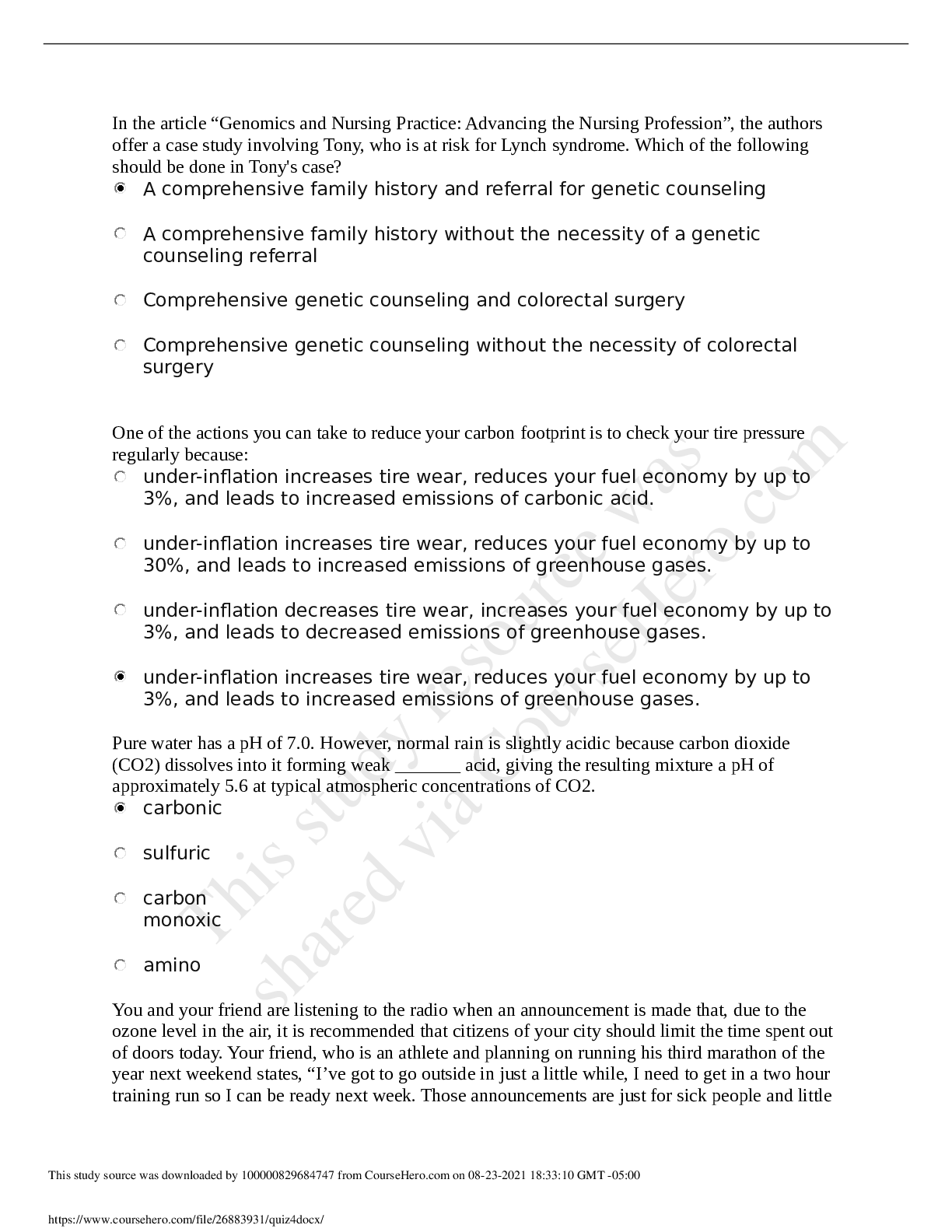
Buy this document to get the full access instantly
Instant Download Access after purchase
Add to cartInstant download
Reviews( 0 )
Document information
Connected school, study & course
About the document
Uploaded On
Aug 16, 2020
Number of pages
23
Written in
Additional information
This document has been written for:
Uploaded
Aug 16, 2020
Downloads
1
Views
117

